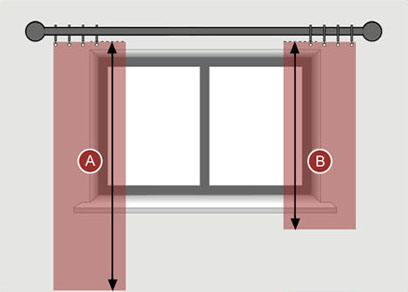How to measure
Use the instructions below to measure for the perfect fit.
- Use a metal measuring tape or wooden yardstick. Flexible cloth tapes are not accurate.
- Be precise. Measure for length and width in three different places.
- Take notes clearly. Indicate which measurement is the width and which is the height. It is very common to mix up the measurements.
- When measuring, don’t be surprised if your window is not square. It probably won’t be noticeable if it’s a little off. Consider an outside mount for blinds and shades, to hide the imperfection.
Horizontal blinds or pleated shades
For inside mount installation:
1. Determine width: Measure (A) where headrail or roller will be installed.
2. Measure length: Measure (B) from top on inside of window casement to windowsill.
For outside mount installation:
1. Determine width: Measure (C) where brackets will be installed. Overlap the window by at least 1½” on each side for light control.
2. Measure length: Measure (D) from top of the window casement to the window sill.
For vertical blinds, use outside mount installation only.
1. Determine width: Measure (C) where headrail will be installed. Headrail must overlap the window or patio door by at least 3” on each side for vanes to stack when the blind is open.
2. Measure length: Measure (D) where the top of the headrail will be installed to the window sill or to the floor.
Pinch-pleated draperies.
1. Determine your rod width:
For center-draw draperies: Rods can be mounted on the window frame, or any place on a wall you want to cover. Decide your bracket position and then measure the width between the brackets. If you don’t already have a traverse rod, add 4” to each side, left and right, to account for return. Return is the measurement from the wall to the face of the rod. Also, if you intend to open draperies to the casement, or desire maximum privacy, insulation and/or light control, the rod should be approximately 15% wider than the window (multiply width by 0.15).
For one-way draw draperies: Measure your window width, add 4” for the return on one side and 1” for drapery to extend past the rod. Also, if you intend to open draperies to the casement, or desire maximum privacy, insulation and/or light control, the rod should be approximately 15% wider than the window. (multiply by 0.15)2. Determine curtain/drapery width:
Once you have determined total rod width, use the chart below to determine the correct pinch pleated drapery width to order.
|
Curtain/Drapery Sizes
|
||||||||||||||||||
|
Pinch-pleated draperies.
-
-
- Determine width. Measure the area to be covered. Unless otherwise instructed in the item description, order at least 2 times the width measured for a full, custom look.
- Determine length. Measure from the top of the rod to the windowsill (B), apron (C) or floor (D). Subtract ½” for floor or sill clearance.
-
Replacing Existing Window Coverings
Measure across the top of panels and down one side of the coverings you already have. Order the closest size.
Use this diagram to help you find the correct measurements.
A – Window width including casement
B – Length to windowsill-subtract ½” for clearance
C – Length to apron
D – Length to floor-subtract ½” for clearance





